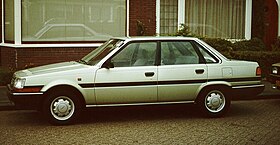Toyota Carina II
| Toyota Carina II | |
|---|---|
 |
|
| Overview | |
| Manufacturer | Toyota |
| Production | 1984-1992 |
| Designer | Toyota |
| Body and chassis | |
| Class | Large family car |
| Related | Toyota Corona |
| Chronology | |
| Predecessor | Toyota Carina A60 |
| Successor | Toyota Carina E |
| First generation | |
|---|---|
 |
|
| Overview | |
| Also called | Toyota Corona |
| Production | 1984–1988 |
| Body and chassis | |
| Class | Large family car |
| Body style | 4-door saloon 5-door liftback |
| Platform | T150-series |
| Related | Toyota Corona T150 |
| Powertrain | |
| Engine | 1.6 L 4A-L I4 (AT151) 1.8 L 1S-LU/ELU I4 (ST150) 2.0 L 2S-E I4 (ST151) 2.0 L 2C diesel I4 (CT150) |
| Transmission | 4/5-speed manual 3/4-speed automatic |
| Dimensions | |
| Wheelbase | 2,515 mm (99.0 in) |
| Length | 4,370 mm (172 in) |
| Width | 1,670 mm (66 in) |
| Height | 1,365 mm (53.7 in) |
| Curb weight | 942 kg (2,077 lb) |
| Second generation | |
|---|---|
 |
|
| Overview | |
| Also called | Toyota Corona |
| Production | 1988–1992 |
| Body and chassis | |
| Class | Large family car |
| Body style | 4-door saloon 5-door liftback 5-door estate |
| Platform | AT171, ST170, CT170 |
| Related | Toyota Corona T170 |
| Powertrain | |
| Engine | 1.6 L 4A-F DOHC I4 (1988-1989) 1.6 L 4A-FE DOHC I4 (1990-1992) 2.0 L 3S-FE DOHC I4 2.0 L 2C diesel I4 |
| Transmission | 4/5 MT 4 AT |
| Dimensions | |
| Wheelbase | 2,530 mm (100 in) |
| Length | 4,440 mm (175 in) |
| Width | 1,690 mm (67 in) |
| Height | 1,370 mm (54 in) |
| Curb weight | 1,140 kg (2,510 lb) |
| Chronology | |
| Successor | Toyota Carina E |
The Toyota Carina line of large family cars was introduced in Japan in 1970. This was introduced in Europe in 1971, with A40 and A60 series subsequently appearing soon after their introductions in Japan. In 1984, the A60 series Carina was replaced in the European market by the "Carina II" - essentially a rebranding of the T150 series Toyota Corona launched the previous year in Japan, with some minor alterations to suit the European markets. This trend of Coronas rebadged as Carinas produced for the European market continued for two more generations, with the second Carina II in 1988 and the Carina E in 1992.
The T150 series was originally launched in January 1983 in Japan as the Toyota Corona, which brought front wheel drive to the model and also began the alignment of Corona, Carina and Celica platforms. The Carina II was introduced in the UK in April 1984 and other European markets in the same year. This generation was made available in sedan or liftback body styles only. It was essentially the same as the Japanese market Corona T150 with some minor cosmetic changes, namely the rear light clusters which were shortened in width to accommodate for larger European number plates. The T150 Carina introduced in Japan in May 1984, while on the same chassis, used completely different body panels featuring squarer, more aggressive styling. To further complicate matters there were also RWD models of both Carina and Corona available in the Japanese market.
Two carburetted petrol engines (1.6 or 1.8) and one diesel option were available, although the 1.8 was only sold in certain markets. Equipment levels were DX and GL, although following a facelift in December 1985 these changed to XL and SX in some markets. The 1.6 was later offered with the option of a catalytic converter (4A-LC), dropping power to 75 PS (55 kW). In August 1985 the 107 PS (79 kW) 2-litre 2S-E engine was added for select markets. Along with the facelift, a fuel injected version of the 1.8 engine was added for the 1.8 GLi. In Germany, at least, this version was only sold until October 1986.
In 1988 the Toyota Carina II was released, based on the Japanese market T170 Corona introduced the previous year. Compared to the Corona, front and rear light clusters, front grille and some trim are different, and the rear number plate recess was moved up from the bumper up to the boot lid. In the generation, beside sedan and liftback body styles, the wagon body style was also available. The car had three engine variants, the 1,587 cc (1.6 L) 4A-FE and 1,998 cc (2.0 L) 3S-FE petrol engines, and a 1,974 cc (2.0 L) 2C diesel engine. Petrol versions were all twin-cam, sixteen-valve inline-four cylinders.
...
Wikipedia
